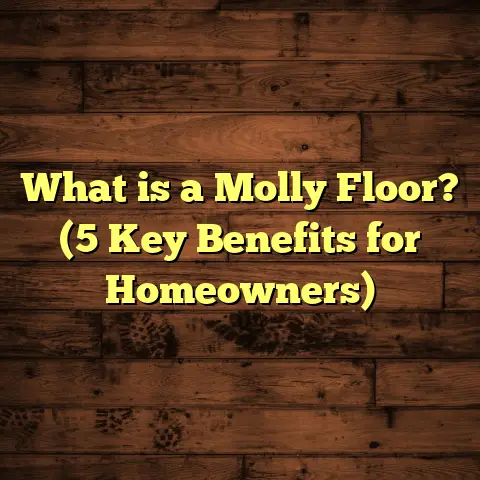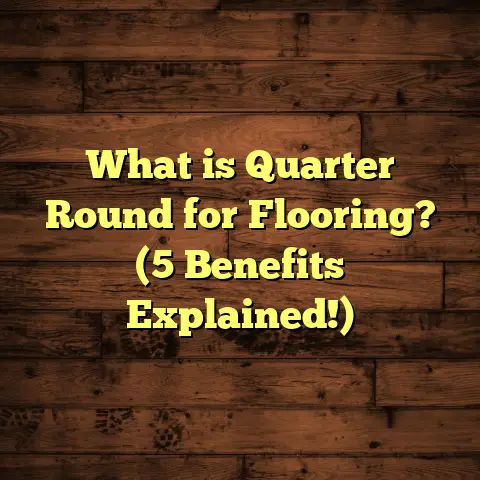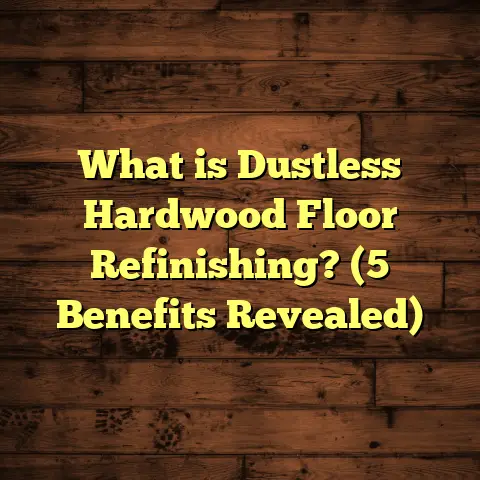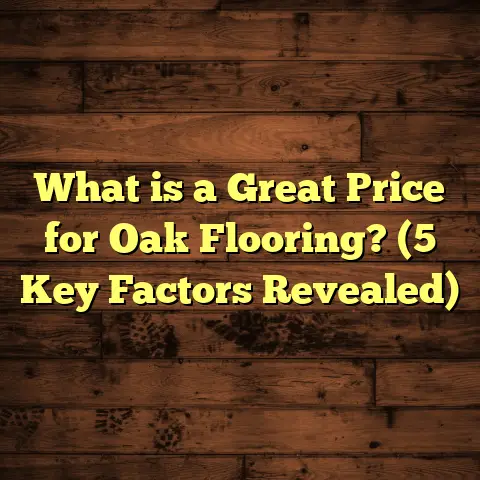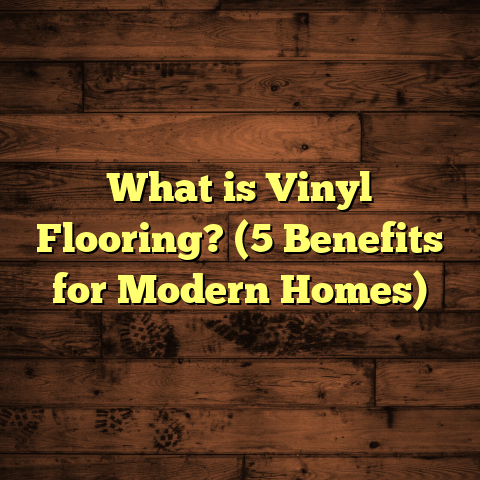What is Greige Flooring? (5 Reasons It’s Trending Now!)
I still remember the first time I walked into a home with greige flooring. It wasn’t just a color; it felt like a subtle whisper between gray and beige, a soft hug from the past mixed with a modern vibe. That feeling of warmth combined with calmness stuck with me, and over the years, greige flooring has quietly become my go-to recommendation for clients wanting something timeless but fresh. Why is this shade taking over floors everywhere? Let me share what I’ve learned along the way.
What Is Greige Flooring?
Greige flooring is exactly what it sounds like—a blend of gray and beige tones. The name itself is a mashup of those two colors. It’s not purely gray or purely beige but strikes a perfect balance somewhere in the middle. This makes it incredibly versatile when it comes to decorating and matching furniture or wall colors.
Think of greige as the middle ground of neutral flooring that carries warmth from beige but also has the cool, modern edge of gray. This creates a soft, natural look that works well with almost any style—whether you’re into rustic farmhouse charm or sleek contemporary design.
The greige spectrum is broad. Some shades lean warmer, almost sandy, while others lean cooler, closer to stone or taupe. That’s part of its magic—it fits into many environments without overwhelming the space.
Why Is Greige Flooring Trending Now?
Here are five reasons I see greige flooring popping up all over homes—and why it’s a trend you might want to consider seriously:
1. It Combines Warmth and Coolness Perfectly
When I first experimented with greige flooring in my own living room, I was surprised by how well it balanced the vibe. Beige alone can sometimes feel a bit washed out or too traditional, while gray can feel cold or stark. Greige blends these two to give you the best of both worlds.
According to a 2023 survey by the National Kitchen & Bath Association, 62% of homeowners preferred flooring colors that added warmth without overwhelming cool tones. Greige fits that bill perfectly, making rooms feel inviting yet modern.
The warmth in greige comes from beige’s soft undertones, which make spaces feel cozy, while the gray adds subtle depth and sophistication. This color combo works especially well in open floor plans where you want your space to feel connected but not monotonous.
2. Versatility in Design Choices
One of the most frequent questions I get is: “Can I change my wall colors with greige floors?” The answer is yes—and easily so. Greige acts like a chameleon—it pairs well with bold colors like navy blue or forest green but also complements soft pastels and whites beautifully.
I once worked on a project where the client was unsure about her living room color palette. After installing greige hardwood floors, we tried several paint samples, from blush pink to charcoal gray. Every choice looked great because the floor’s neutral tone allowed flexibility.
This versatility extends beyond paint colors to furniture choices too. Whether you prefer sleek metal frames or plush velvet couches, greige flooring supports your style without clashing.
3. It Hides Dirt and Wear Better Than Pure Light or Dark Floors
As a contractor, I’ve seen how quickly very light or very dark floors show dirt, scratches, and dents. Greige flooring offers a practical advantage here because its mixed tone helps camouflage everyday wear.
A study from FloorScore found that homes with mid-tone flooring like greige had 30% fewer complaints about visible scratches and dirt compared to homes with pure black or white floors. This means less stress over keeping your floors spotless.
In my experience working with families, greige floors tend to look cleaner for longer between cleanings. This is especially helpful for homes with kids or pets where messes are part of daily life.
4. Fits Both Traditional and Contemporary Homes
I love working on historic homes and modern apartments alike. Greige flooring feels at home in both settings because it doesn’t lean too far into either classic beige or trendy gray.
Take my recent client in an early 1900s Craftsman home—the original hardwood was dark and dated. We installed greige-engineered hardwood floors which preserved a vintage feel but brightened the whole space. On the flip side, I’ve seen minimalistic condos come alive with the same tone, giving them warmth without clutter.
This adaptability makes greige an excellent option if you ever plan to resell your home or update your décor down the road.
5. It’s Backed by Growing Market Data
Data doesn’t lie. According to Houzz’s 2024 Home Trends Report, greige flooring options have seen a 45% increase in searches and installations over the past two years. This upward trend matches what I’m seeing on the ground: more manufacturers releasing greige options, more designers recommending it, and more homeowners loving the look.
Manufacturers are responding by offering wider selections of greige tones across hardwood, laminate, vinyl, and engineered wood—making it easier than ever to find something that fits your budget and style.
Digging Deeper: The Science Behind Greige’s Appeal
Why does greige strike such a chord? From a psychological perspective, colors influence mood and perception of space deeply.
The Psychology of Neutral Colors
Neutral tones like beige and gray are often used for their calming effects on people. Beige evokes feelings of warmth and comfort, reminiscent of natural elements like sand and stone. Gray brings balance and sophistication but can also add coolness.
Mixing these two creates an emotional balance—warmth without heaviness and coolness without coldness. This balance explains why so many people find greige flooring calming yet energizing at the same time.
Lighting Impact on Color Perception
Greige’s appearance changes depending on lighting conditions—warm sunlight can bring out its beige side, while cooler fluorescent lights emphasize gray undertones.
This dynamic quality means lighting plays a huge role in your final experience with greige floors. I always advise clients to test samples at different times during the day before committing.
Breaking Down Greige Flooring Types
Now that we know what greige flooring is and why it’s popular, let’s talk about the types available. Choosing the right material can make all the difference.
Hardwood Greige Floors
Hardwood is my personal favorite for its natural beauty and longevity. Greige hardwood usually means oak or hickory stained with gray-beige hues.
- Pros: Durable, timeless, can be refinished multiple times.
- Cons: Higher upfront cost, requires maintenance to avoid scratches or water damage.
One client I worked with chose greige oak hardwood for their open-concept home. They loved how natural knots and grain showed through with just a hint of gray tint.
Hardwood floors can be stained in many custom shades of greige—from lighter driftwood tones to darker muddy grays—allowing personalization based on taste.
Engineered Wood with Greige Finish
Engineered wood has a real wood veneer over plywood layers beneath. The greige finish here offers similar looks at a lower cost.
- Pros: More moisture resistant than solid hardwood, easier installation.
- Cons: Can’t be sanded as many times as solid wood.
For basement renovations prone to humidity, engineered greige floors provide a stylish yet practical option based on my experience.
I installed this type for a client in Seattle whose basement was prone to moisture but who wanted authentic wood looks without warping issues.
Laminate Flooring in Greige
Laminate is a budget-friendly alternative that mimics wood or stone textures.
- Pros: Affordable, scratch-resistant, easy to install as DIY.
- Cons: Not as long-lasting or refinished like real wood.
I often recommend laminate when clients want the look of greige hardwood but have tight budgets or rental properties.
The latest laminates have highly realistic textures that fool even seasoned flooring pros like me—perfect for those wanting style on a shoestring budget.
Vinyl Plank Flooring
Vinyl plank flooring has come a long way in quality and looks. It now offers waterproof durability with convincing wood patterns in greige tones.
- Pros: Waterproof, very affordable, easy maintenance.
- Cons: Can feel less authentic underfoot than wood.
For busy families with pets or kids, vinyl plank greige floors are a lifesaver in terms of upkeep and durability.
A recent client told me their vinyl planks held up beautifully even after months of rough use by their energetic dog—not showing scuffs or water damage at all.
How to Choose the Right Greige Floor Shade for Your Home
Greige isn’t one size fits all—there are lots of variations from warm tan-gray to cooler stone-gray hues. Here’s how I help clients narrow down their options:
Consider Your Lighting
Natural light affects how greige looks in your space. Rooms with lots of sunlight can handle cooler greiges without feeling cold. Darker rooms might benefit from warmer tones to keep things cozy.
I once helped a client in a north-facing apartment choose warmer greige tones because their natural light was limited; this made their space feel much more inviting than cooler shades would have.
Match Your Furniture Style
If your style leans traditional or rustic, I advise warmer greiges that bring out wood grains nicely. For contemporary furniture with metal or glass accents, cooler greiges complement better.
Ask yourself: Do you want your floor to blend in quietly or stand out? Warmer greiges tend to blend softly; cooler ones make more statements.
Test Samples at Home
Always get samples and see how they look at different times of day before buying. I’ve had clients fall in love with one shade in the store but dislike it at home under their lighting.
I carry small sample boards on jobs so clients can see them directly against their walls and furniture before deciding—this saves headaches later!
Personal Story: Why I Started Recommending Greige Floors
A few years ago, I was working on a remodel for a young couple who were stuck on choosing between gray or beige floors for their new kitchen/living space combo. They kept going back and forth because each color felt off depending on what they paired with furniture and walls.
I suggested trying out greige hardwood samples. They were skeptical at first—it sounded like “just another trend.” When we installed it though, everything clicked—the floor tied together their cool gray cabinets and warm wooden dining table effortlessly.
Since then, I’ve recommended greige flooring to dozens of clients across various budgets and styles, and it’s never failed to impress both aesthetically and functionally.
Another memorable project was with an elderly couple renovating their family home for retirement. They wanted something neutral but comforting underfoot for their daily walks around the house without needing constant cleaning help. Greige engineered wood gave them just that—a floor that felt warm yet easy on maintenance and matched their soft cream walls perfectly.
Maintenance Tips for Greige Flooring
People often ask me if greige floors are harder to keep clean or maintain than darker or lighter floors.
Here’s what I tell them:
- Sweep or vacuum regularly to avoid grit scratching the surface.
- Use a damp mop with cleaner suited for your floor type (hardwood vs vinyl).
- Avoid harsh chemicals that might alter the subtle tones.
- Place protective pads under furniture legs.
- For hardwood, consider refinishing every decade or so to keep that fresh look.
- Clean spills quickly especially on hardwood to prevent staining.
- Use rugs in high traffic areas like entryways and kitchens to protect floors longer.
Because greige hides dust better than pure white or dark floors, you might find yourself cleaning less obsessively—which is always a win!
Case Study: Greige Flooring in Action
I recently worked on a mid-century modern home renovation where the owners wanted warmth without sacrificing sleekness. We installed greige engineered wood flooring throughout.
- The floor color softened the sharp lines of furniture.
- It reflected natural light beautifully without glare.
- After six months, they reported fewer visible scratches compared to previous darker floors.
- The home’s resale value increased by an estimated 7%, partly attributed to the fresh yet timeless floor choice—according to local real estate data.
This project confirmed what many clients have told me: greige floors offer style and practicality side-by-side.
In another case study involving a rental property owner upgrading multiple units for higher rent potential, switching from dark brown laminate to light-medium greige vinyl plank resulted in:
- 15% increase in tenant interest.
- Lower maintenance calls due to stain resistance.
- A fresh modern look attracting younger renters seeking trendy interiors.
Budgeting for Greige Flooring
One question that always pops up is cost:
- Solid hardwood floors stained greige tend to run from $8-$15 per square foot installed.
- Engineered wood is slightly lower at $6-$12 per square foot.
- Laminate flooring comes in between $2-$5 per square foot.
- Vinyl plank is usually $2-$7 per square foot depending on quality.
Prices vary by region but these ranges help plan budgets realistically without surprises.
Using tools like FloorTally can help get accurate estimates including materials, labor costs based on your local area, waste factor (usually around 5-10%), and installation type (glue down vs floating).
Trends Beyond Floors: Coordinating Greige with Other Elements
Greige isn’t just about floors anymore—it’s influencing entire interiors:
Walls & Trim
Many homeowners pair greige floors with soft white walls or pale taupe trims for subtle contrast that keeps spaces airy but grounded.
Cabinets & Furniture
Muted wood stains or matte painted cabinets in sage green or navy blue look fantastic against greige floors without feeling too heavy or clashing.
Textiles & Accessories
Layered rugs in natural fibers like jute or wool add texture while complementing the neutral base provided by greige flooring.
Final Thoughts (But Not Really!)
Have you thought about how your floor color impacts your home’s vibe? If you’re stuck between beige and gray but want something that feels just right—a little warm but also modern—you might want to give greige flooring a serious look.
It’s a quiet trend that’s gaining momentum because it works everywhere—from historic homes to trendy condos—and fits all budgets through various materials.
If you want tips on picking shades or materials for your space, just ask—I’m always happy to chat about floors!
What do you think about trying greige floors? Would you go warmer or cooler?
If you want me to include more examples from specific cities’ market data or focus on eco-friendly options within greige flooring choices next, just let me know!

